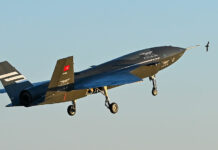A derivative of the operational Harpy radar killer drone, developed and built by IAI/MBT is proposed as a hunter-killer drone, operated from land based truck mounted launchers or from ship based launchers. The unmanned weapon, will be able to strike targets of opportunities such as silent enemy air defense weapons, and ballistic missile launchers.
The joint program was initially proposed by IAI/MBT and Raytheon as “Cutlass” for Combat Uninhabited Target Locate and Strike System. Initially displayed in the Paris Air Show in 1999, the system combined the airframe of the Harpy UAV, made by Israel Aircraft Industries, with advanced sensors made by Raytheon Systems, which also manufactures the HARM (High Speed Anti-Radiation) missile. Cutlass was adapted for ship-based operations to support US Navy operations over land. It is designed for six hours missions, flying at speed of 100 knots and maximum range of 1,000 km.
Unlike the autonomous Harpy, Cutlass also has a direct line-of-sight datalink capability at range up to 150 km. This range can be extended via relays built into each weapon. Like Harpy, Cutlass primarily is a SEAD weapon, relying on a blast-fragmentation warhead, but Cutlass is different from Harpy in its semi-autonomous mode of operation. When a potential target is located, the information is data-linked to an operator in the ground station to confirm target identification and to provide positive man-in-the-loop attack permission. With different seekers, the killer drone can also be used for hunting of ballistic missile launchers, urban warfare, and attacking vehicles. Other potential missions for an unarmed version of the Cutlass could be reconnaissance, target acquisition and battle-damage assessment, he said. It operates at an altitude of 6,000 feet, to avoid ground fire.
In October 2005 a derivative of Harpy presented by MBDA in cooperation with IAI/MBT Division was selected as one of the finalists for the UK Loitering Munition Capability Demonstration (LMCD) program.
















